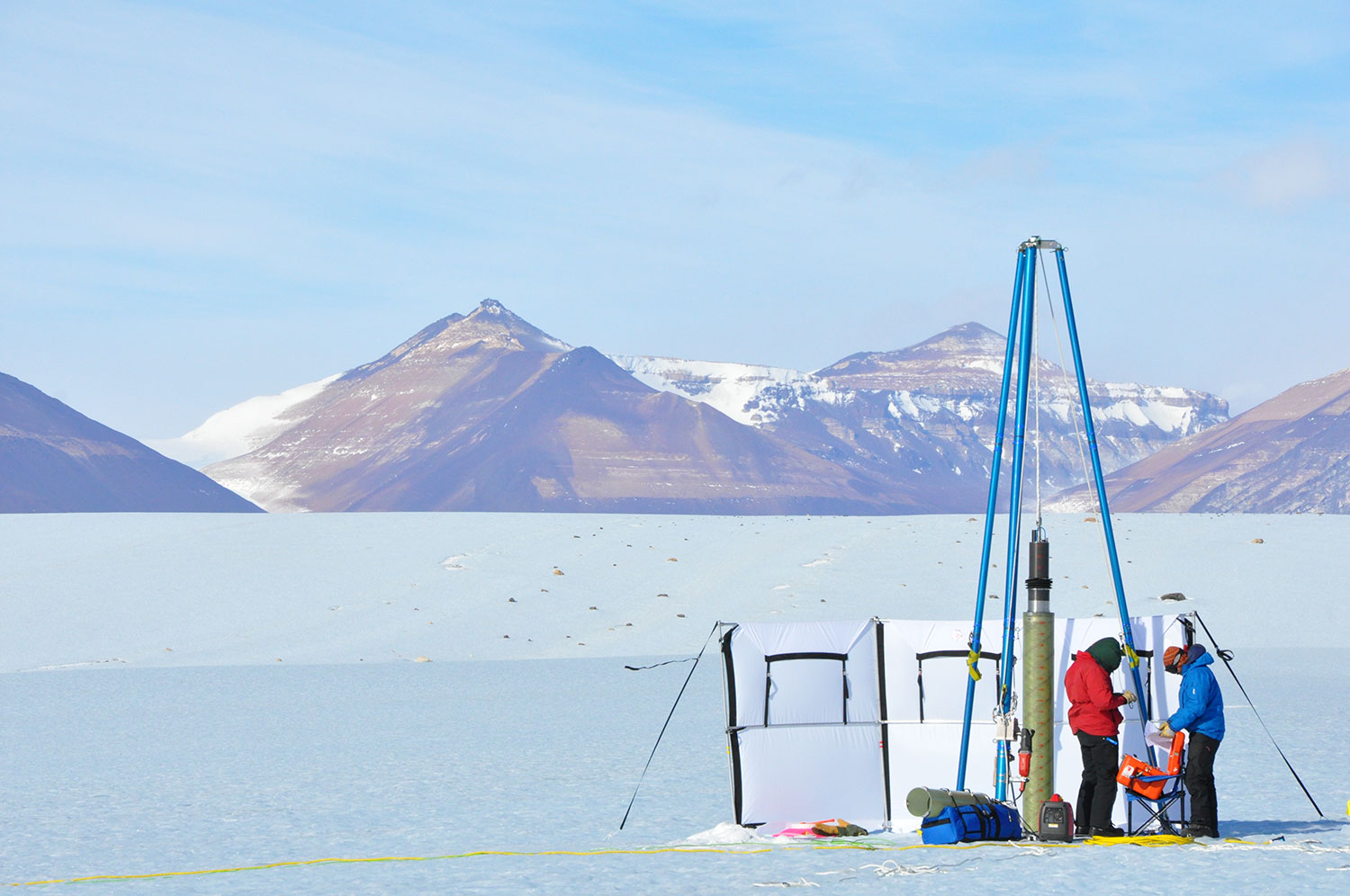Acting Student and Bioengineering Alumna Awarded Soros Fellowship for New Americans
Awards & Accolades

Collecting ice samples at Antarctica's Taylor Glacier
An analysis of air bubbles from glacial ice cores shows that the last time the planet experienced rapid warming, there was not a giant release to the atmosphere of the greenhouse gas methane from frozen methane deposits, a scenario some have feared could be repeated in the near future as the planet warms.
In the study led by current and former researchers from Scripps Institution of Oceanography at the University of California San Diego, scientists analyzed the chemical signature of methane that was present in the atmosphere during an abrupt warming event 11,600 years ago. The researchers harvested the ice from Antarctica’s Taylor Glacier, and found no detectable contribution from the naturallyoccuring fossil deposits of frozen methane that are common in permafrost and ocean sediments.
There had been a 50 percent increase in atmospheric methane levels during the warming event, which took place as the planet transitioned out of an ice age. Most of that increase, though, was from methane produced microbially in tropical wetlands.
“This finding is important because it shows that the idea of a ‘methane time bomb’ coming from warming sediments and permafrost is one thing we don't have to worry about in connection with global warming,” said Scripps Oceanography geoscientist Jeff Severinghaus, who has been involved with this research project since 2000 and leads the study of ice core records at Scripps.
Severinghaus’ former student at Scripps, Vasilii Petrenko, now of the University of Rochester, led the study “Minimal geologic methane emissions during Younger Dryas – Preboreal abrupt warming event” that appears Aug. 24 in the journal Nature. The National Science Foundation (NSF) led funding of the research, which involved the extraction and transport of dozens of 2,000-pound blocks of ice from Antarctica over the course of a decade.
Many scientists had proposed that the burst in global methane levels during the episode nearly 12,000 years ago must have been caused by large emissions of methane suddenly released from Arctic lakes, permafrost, or through the melting of methane hydrates – solid forms of methane that exist on the seafloor at cold temperatures and under great pressure. The warming episode saw global temperatures rise by 3° C (6° F), and in one region of the North Atlantic Ocean by 11°C (20° F) over several centuries.
A concern has arisen in recent years that current planetary warming, especially at the poles, could trigger a similar sudden release of methane. Since methane is a more potent warming agent than carbon dioxide, the chief anthropogenic greenhouse gas, some scientists and policymakers have considered a scenario in which a methane burst creates a sudden acceleration of climate instability.
The team led by Petrenko was able to distinguish the origin of the methane in the bubbles of air trapped in the Antarctic ice. So-called “fossil methane” is the type associated with Arctic lakes and permafrost. Scientists can distinguish it in the laboratory because it lacks a certain chemical form – known as a carbon isotope – that is found in methane from other sources such as wetlands.
The amount of fossil methane found in the samples was negligible, meaning the methane explosion of 11,600 years ago had little to do with permafrost or frozen methane melting and much more to do with known changes in rainfall closer to the equator. The researchers believe that soil and marine bacteria that feed on frozen fossil methane as it melts may explain its limited release, by preventing the methane from ever reaching the atmosphere.
The researchers said that there is a flipside implication of the finding, however. Fossil methane is also leaked into the atmosphere by the extraction and use of fossil fuels today. The amount produced by natural geologic sources is believed to be about the same as it was during the ancient rapid warming event. If the contribution of geologic sources of fossil methane then has been overestimated, the present-day contribution of fossil methane must also be overstated.
That means that the amount of fossil methane produced by human activities today is likely to be underestimated. The research team said its finding suggests that the amount of methane put into the atmosphere by human activities may be undercounted by 25 percent or more.
“The ancient air samples reveal that these kinds of scenarios regarding natural methane emissions are not as important to take into account for future planning,” Petrenko said. “In contrast, anthropogenic fossil fuel emissions seem to be even larger than we previously thought so reducing these levels has more leverage to mitigate global warming.”
Besides Petrenko and Severinghaus, contributors to the study include Ray Weiss and Christina Harth from Scripps, and researchers from the Australian Nuclear Science and Technology Organization, the National Institute of Water and Atmospheric Research in New Zealand, Oregon State University, the University of Bern in Switzerland, University of Grenoble in France, the University of Utah, the University of Cambridge, and the Laboratoire des Sciences du Climat et de l’Environnement in France.
Severinghaus’ share of the study was supported by NSF Award 0839031.
Keep up with all the latest from UC San Diego. Subscribe to the newsletter today.